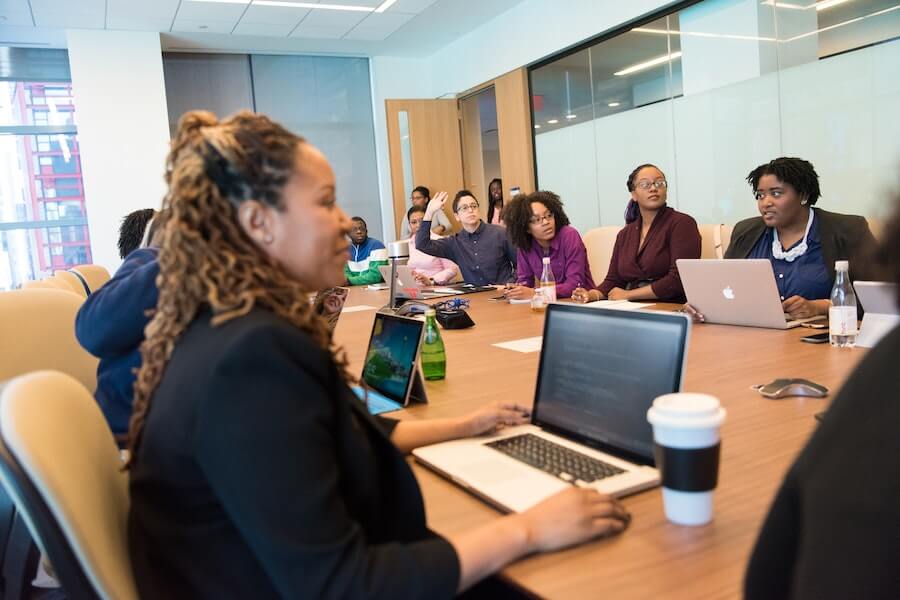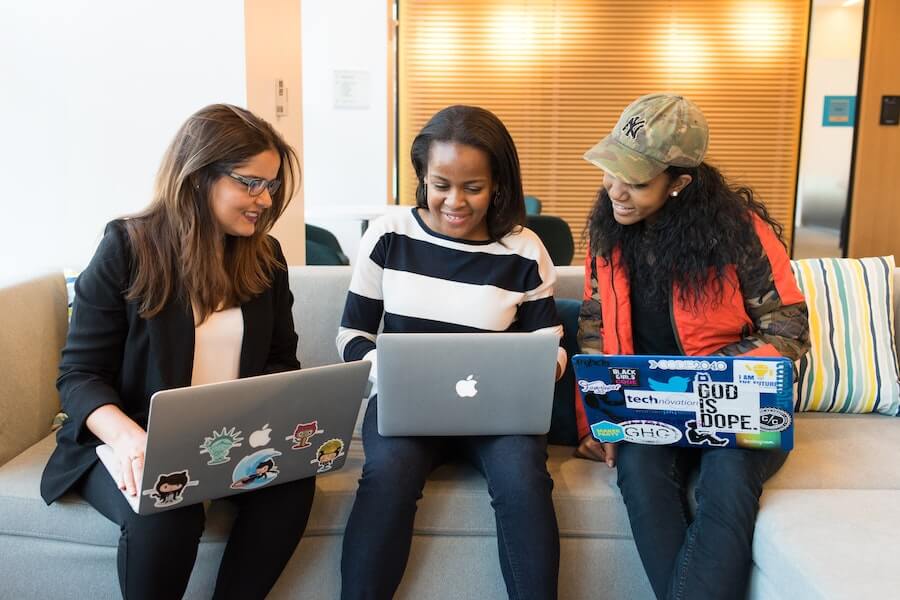Are you trying to work out whether it would be better to learn from home or go and learn in the classroom or lecture hall? This blog weighs up the pros and cons of both distance and face to face learning methods.
There is no right and wrong answer. What suits one person may not be the best way for someone else to learn. And it is these shifting sands that make it difficult to say that some students work best with a face-to-face course whilst another set will fare better under distance learning courses.
The answer is, essentially, a personal one. But if you decided to return to education or to bolster your skill set with some new qualifications, you have a choice to make: distance lessons and lectures or face to face learning.
The Pros and The Cons

As you would expect, there are upsides and downsides to both, some of which we cover here. Of course, you may read through the list of each and decide that what it a con is a pro, and vice versa, for you personally.
Distance learning is also known as online learning, e-learning, open learning or learning from home. You may pay for the course upfront and receive all the materials in one shipment or you may pay monthly with some providers, with course materials released as you complete (and pay) for modules or units. Distance learning is great if you are looking to learn a new language, become an accountant or develop your digital skills.
Face to face learning can be defined as the traditional style of learning in which you show up at a venue at the same time for a number of sessions. You will be taught or tutored by an instructor or teacher, following a prescribed schedule of taught sessions called a curriculum.
Distance Learning

Pros | Cons |
Distance learning is possibly one of the most FLEXIBLE study options open to the modern student, irrespective of their age, working status and so on. | You do need to COMMIT to your course, which means understanding the difference between flexibility and ‘not really bothering’. If you don’t have a strong sense of discipline or are not interested in forming one when it comes to your studies, distance learning may not be for you. |
You can study in a space in which you feel most COMFORTABLE. This could be at the kitchen table or even curled up on the couch. | Studying on the couch is all well and good but you also need to be prepared for the fact that there are times, with deadlines looming and assignments pressing that you need to create a study space that is conducive to learning. Sometimes, lounging on the sofa is not the best space… |
For many students of open learning, the PACE at which they complete their course is dictated by no one other than themselves. If you don’t grasp a concept initially, you can go over the module again, for example. | Pace is one thing, not applying yourself is something completely different. When pace is lacking, or the feeling that there is no one else there to drive your learning, making time to study can fall by the wayside.
|
It can FIT AROUND YOU and your work, family and social commitments. Many people find that the course is so well structured that they are able to pick it up after a few weeks break if they have to re-schedule their learning. | Fitting it around life is one aspect of distance learning but you also need to ensure you value your course too. So, when you can’t study at a certain time because ‘life happens’ when you will re-schedule your study time for? |
You are in the DRIVING SEAT. You have complete control of your daily learning hours. | Are you organised? Can you push through and stay motivated to complete the course? |
Face to face learning
Choosing the right distance learning course and provider is essential. You need to be confident that the course and its content, as well as the qualification once you have completed it, have the same ‘value’ as that of a course completed at a college or a training provider. For some employers and organisations, knowing that as a student you can organise your own learning and successfully complete a course speaks volumes. There are many more benefits to distance learning – so it’s an option that is really worth exploring.

Which type of course delivery do you think would suit you?
Social media is a powerful platform in many ways. But just as it can be used for positive gain, it can also quickly turn into an uncontrollable monster.
For students and tutors alike, harnessing the power of the digital world as part of a course is now part and parcel of delivering vibrant learning experiences.
However, social media should not be included in course material and student’s learning solely because it is the ‘modern thing to do.’ It needs to enhance a student’s learning and contribute to improving their learning outcomes. If these conditions are met, it can be a welcome and useful part of a teaching practice.
So, how can tutors and learners grasp the sometimes-thorny issue of social media in learning?

Most learning providers suggest that staff and students create accounts that are specifically for professional use so that personal accounts are not compromised.
#1 Include it in course details, syllabus and description
Some students and tutors are ‘frightened’ or wary of social media. It can be an unruly beast, and for some worry that their profiles could be vulnerable to attack or hijacking.
This is why online learning providers who do use social media include this detail in course descriptions and their syllabus, offering additional support to students who need to create online profiles.
Social media is not just about updating your Facebook status or tweeting as a contribution to a discussion. Some course providers are also harnessing the power of open blogging sites (such as Blogger) to publish work and facilitate discussion over certain texts.
There also need to be options for students who are not willing or able to share in the social media aspects of the course.
#2 Contracts and permissions
Social media (including blogging sites) are public mediums, and this means that students need to be prepared to use them correctly. Signing a contract between student and tutor on how these platforms will be used is essential.
Encourage students to use aliases if this makes them feel more comfortable. You should also create guidelines that help them stay safe when online, and add to these guidelines as and when experience dictates. Ask students to contribute to these guidelines.
#3 Link to institutional policies
Learning providers will often have policies relating to the use of social media sites in terms of what can and cannot be used and/or shared. These are important policies that are put in place to protect the institution, its reputation, staff and students.
Both students and tutors need to be aware of the disciplinary process, as online abuses can have far reaching consequences.
#4 Safety
Mentioned in a previous point, you can encourage students and tutors to use an alias to protect their identity and the integrity of their work. These aliases need to be appropriate, but also communicate throughout the group so that students and tutors can identify each other online.
There are also some social media sites that allow ‘member only’ access, and this is a useful additional security filter.
#5 Teach responsible social media use
On a personal level, we all think we know how to deal with social media, but the ways in which people interact differs from person to person.

Social media is not just about updating your Facebook status or tweeting as a contribution to a discussion.
In ‘real life’, people argue, and social media is no different. Interactions can be tense and exchanges short and terse. Posts and words can be published ‘without a filter,’ with no regard to whether the content could offend, or whether it is appropriate or not.
As well as appropriate and responsible use, there is also the consideration needed of whether sharing some works online is legal. Students and tutors need to understand the Creative Commons licence and how it applies to other people’s work and their own.
#6 Not to be used for feedback
Student feedback (and vice versa) should be given via the learning management portal, and not via open or closed-group social media sites.
#7 Create learning accounts
Students and tutors may have a whole plethora of personal social media accounts. Most learning providers suggest that staff and students create accounts that are specifically for professional use, so that personal accounts are not compromised.
#8 Consider whether it is the best platform
Social media platforms and channels will all have differing Terms of Service. Consider these carefully, because if service is discontinued, your students work will be lost. As with all technology, always have a Plan B.
Online Courses, Learning and Teaching
Online courses and distance learning have gained momentum in recent years. There is now a wide-range of courses available to the home learning student, from online marketing courses to beautician courses, psychology courses and more.
How do you think social media can be used to enhance your learning?
Planning the perfect wedding is only a step away with this great timeline from engagement to wedding day…
12 Months before the Big Day
The question has been asked and the champagne corks have been popped – and now the real work starts. Planning your wedding doesn’t have to be a difficult task but it does mean being organised:
- Pick the wedding date and time – send out ‘save the date’ card, always a good idea for the busy ‘wedding season’ of summer
- Decide on your budget
- Start looking for a suitable venue that is both available on your chosen date and big enough for the ceremony, reception and evening party (if you are planning your wedding this way)
- Consider enrolling on a wedding planner course

10 Months Before the Big day
Wedding dress – in order for a wedding dress to fit perfectly, it will need to be altered to be a custom fit. Shop for, buy and start the alteration process for your wedding dress.
As well as the dress, consider;
- entertainment options
- start looking for a photographer, videographer, reception band or DJ and florist
- reserving accommodation for out-of-town guests
- wedding insurance to protect deposits etc.
- a gift register, if using
6 to 8 Months Before Your Big Day
With only a few short months left, you need to start nailing down some of the arrangements;
- order bridesmaids’ dresses
- book the entertainment for the reception as well as ceremony musicians
4 Months Before the Big Day
The day is now hurtling towards you at lightning speed;
- the groom, best man and ushers need to finalise their wedding attire, buying or hiring it including shirts and shoes
- buy the wedding rings

- some couples also attend pre-wedding counselling too
3 Months Before the Big Day Arrives
With 12 weeks to go, preparations are really heating up;
- design and create your wedding cake with your chosen wedding cake specialist
- book wedding day transport, planning and working out the logistics of the day with the transport company
- order invitations
- write your invitations and post out first class – always include an RSVP date
- create a ‘live’ guest list ensuring that attending and non-attending guests are made a note of as soon as their RSVP arrives.
2 Months Before the Big Day
With the hard work and majority of organising done, you can afford to relax and begin to look forward to the big day.
- Some couples write their own vows and now is the time to do this
- Purchase gifts for your parents, bridesmaids, best man and ushers
- For the bride, book a hair stylist and try out different hair styles that match the theme of the day and your dress
- Book a make-up artist and again, enjoy several trial runs to get your look just right

1 Month Before the Big Day
The final four weeks is about checking that everything you need is in place and that means;
- Getting all the paperwork in order, including the displaying of your marriage banns
- Have your final wedding dress fitting
- Check with the florist, wedding car hire company, baker, venue, ceremony hosts etc. that everything is in place and as it should be
2 Weeks Before
You should have all the RSVPs back by now, thus you can start creating the wedding table plan for the wedding breakfast. There will be changes so don’t get too stressed about this.
As well as this, you will also need to;
- Create a list of must-have photos for your wedding photographer, as well as a detailed plan for the videographer if using
- For the DJ or band, discuss the set list and any must-have songs you want including
And finally, enjoy some ‘me’ time with a pre-wedding haircut and colour.

7 Days to the Big Day
There are small arrangements that need finalising such as;
- Final head count to the venue and caterers
- Final changes to the seating plan
- Create table centrepieces (unless the venue is doing this), including favours for wedding guests, name plates etc.
- Confirm delivery details with florist, bakers and wedding dress shop etc.
- Confirm times with hair stylist and make-up artist
- Rehearse the ceremony, if needed
- Check the timings for the day and ensure that these are communicated to all concerned!
On the Day!
Relax, enjoy it and let the day flow!
Wedding planner courses are not just for budding wedding planners. Many couples find the idea of arranging such a big event daunting, which on its own can create many issues. A wedding planner course is helpful in dealing with the behind-the-scenes arrangements, as well as wedding etiquette and the legalities of tying the knot.
